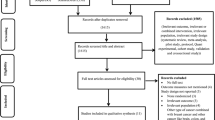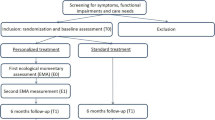Abstract
Purpose
Many breast cancer patients experience (severe) menopausal symptoms after an early onset of menopause caused by cancer treatment. The aim of this study was to assess the cost-effectiveness of cognitive behavioral therapy (CBT) and physical exercise (PE), compared to a waiting list control group (WLC).
Methods
We performed a cost-effectiveness analysis from a healthcare system perspective, using a Markov model. Effectiveness data came from a recent randomized controlled trial that evaluated the efficacy of CBT and PE. Cost data were obtained from relevant Dutch sources. Outcome measures were incremental treatment costs (ITCs) per patient with a clinically relevant improvement on a measure of endocrine symptoms, the Functional Assessment of Cancer Therapy questionnaire (FACT-ES), and on a measure of hot flushes, the Hot Flush Rating Scale (HFRS), and costs per quality-adjusted life years (QALY) gained over a 5-year time period.
Results
ITCs for achieving a clinically relevant decline on the FACT-ES for one patient were €1,051 for CBT and €1,315 for PE, compared to the WLC. The corresponding value for the HFRS was €1,067 for CBT, while PE was not more effective than the WLC. Incremental cost-utility ratios were €22,502/QALY for CBT and €28,078/QALY for PE.
Conclusion
CBT is likely the most cost-effective strategy for alleviating treatment-induced menopausal symptoms in this population, followed by PE. The outcomes are sensitive to a reduction of the assumed duration of the treatment effect from 5 to 3 and 1.5 years.
Implications for Cancer Survivors
Patients can be prescribed CBT or, based on individual preferences, PE.


Similar content being viewed by others
References
Holmberg L, Iversen OE, Rudenstam CM, et al. Increased risk of recurrence after hormone replacement therapy in breast cancer survivors. JNCI. 2008;100:475–82.
Toniolo PG, Levitz M, Zeleniuch-Jacquotte A, et al. A prospective study of endogenous estrogens and breast cancer in postmenopausal women. JNCI. 1995;87:190–97.
Quella SK, Loprinzi CL, Sloan JA, et al. Long term use of megestrol acetate by cancer survivors for the treatment of hot flashes. Cancer. 1998;82:1784–88.
Duijts SFA, Van Beurden M, Oldenburg HSA, et al. Efficacy of cognitive behavioral therapy and physical exercise in alleviating treatment-induced menopausal symptoms in patients with breast cancer: results of a randomized, controlled, multicenter trial. JCI. 2012;30:4124–33.
Short PF, Moran JR, Punekar R. Medical expenditures of adult cancer survivors aged <65 years in the United States. Cancer. 2011;117:2791–800.
Parry C, Kent EE, Mariotto AB, et al. Cancer survivors: a booming population. Cancer Epidemiol Biomarkers Prev. 2011;20:1996–2005.
Herrmann C, Cerny T, Savidan A, et al. Cancer survivors in Switzerland: a rapidly growing population to care for. BMC Cancer. 2013;13.
Jefford M, Rowland J, Grunfeld E, et al. Implementing improved post-treatment care for cancer survivors in England, with reflections from Australia, Canada and the USA. Br J Cancer. 2013;108:14–20.
Hellbom M, Bergelt C, Bergenmar M, et al. Cancer rehabilitation: a Nordic and European perspective. Acta Oncol. 2011;50:179–86.
Mattioli V, Montanaro R, Romito F. The Italian response to cancer survivorship research and practice: developing an evidence base for reform. J Cancer Survivorship : Res Prac. 2010;4:284–9.
Duijts SFA, Oldenburg HSA, van Beurden M, et al. Cognitive behavioral therapy and physical exercise for climacteric symptoms in breast cancer patients experiencing treatment-induced menopause: design of a multicenter trial. BMC Women's Health. 2009;9.
Fallowfield LJ, Leaity SK, Howell A, et al. Assessment of quality of life in women undergoing hormonal therapy for breast cancer: validation of an endocrine symptom subscale for the FACT-B. Breast Cancer Res Treat. 1999;55:189–99.
Hunter MS, Liao KLM. A psychological analysis of menopausal hot flushes. Brit J Clin Psychol. 1995;34:589–99.
Mann E, Smith MJ, Hellier J, et al. Cognitive behavioural treatment for women who have menopausal symptoms after breast cancer treatment (MENOS 1): a randomised controlled trial. Lancet Oncol. 2012;13:309–18.
Ware Jr JE, The SCD, MOS. 36-item short-form health survey (SF-36). I. Conceptual framework and item selection. Med Care. 1992;30:473–83.
Yost KJ, Eton DT. Combining distribution- and anchor-based approaches to determine minimally important differences: the FACIT experience. Eval Health Prof. 2005;28:172–91.
Col NF, Guthrie JR, Politi M, et al. Duration of vasomotor symptoms in middle-aged women: a longitudinal study. Menopause. 2009;16:453–7.
Nachtigall LE, Nachtigall MJ. Menopausal changes, quality of life, and hormone therapy. Clin Obstet Gynecol. 2004;47:485–88.
Netherlands Cancer Registry managed by CCCN. Requested data Utrecht, 2012.
Netherlands S. Mortality statistics. The Hague: Statistics Netherlands; 2011.
Ara R, Brazier J. Deriving an algorithm to convert the eight mean SF-36 dimension scores into a mean EQ-5D preference-based score from published studies (where patient level data are not available). Value Health. 2008;11:1131–43.
Lidgren M, Wilking N, Jönsson B, et al. Health related quality of life in different states of breast cancer. Qual Life Res. 2007;16:1073–81.
Hakkaart-Van Roijen L, Tan SS, Bouwmans CAM. Manual for cost research: methods and standard cost prices for economic evaluations in health care. Diemen: Health Care Insurance Board, 2010
Retèl VP, Joore MA, Knauer M, et al. Cost-effectiveness of the 70-gene signature versus St. Gallen guidelines and Adjuvant Online for early breast cancer. JC. 2010;46:1382–91.
Raad voor de Volksgezondheid en Zorg. Zinnige en duurzame zorg. Zoetermeer, 2006.
Briggs AH, Goeree R, Blackhouse G, et al. Probabilistic analysis of cost-effectiveness models: choosing between treatment strategies for gastroesophageal reflux disease. Med Decis Making. 2002;22:290–308.
Gordon LG, Beesley VL, Scuffham PA. Evidence on the economic value of psychosocial interventions to alleviate anxiety and depression among cancer survivors: a systematic review. Asia Pac J Clin Oncol. 2011;7:96–105.
Mewes JC, Steuten LMG, IJzerman MJ, et al. Effectiveness of multidimensional cancer survivor rehabilitation and cost-effectiveness of cancer rehabilitation in general: a systematic review. Oncologist. 2012;17:1581–93.
Acknowledgments
Janne C. Mewes, Lotte M.G. Steuten, and Wim H. van Harten were supported by a grant from Alpe d’HuZes, a foundation that is part of the Dutch Cancer Society (KWF Kankerbestrijding). This study is part of the A-CaRe Program, www.a-care.org. The authors acknowledge the A-CaRe2Move Research Group.
Conflict of interest
The authors declare that they do not have a conflict of interest.
Author information
Authors and Affiliations
Corresponding author
Additional information
Wim H. van Harten and Neil K. Aaronson contributed equally.
Rights and permissions
About this article
Cite this article
Mewes, J.C., Steuten, L.M.G., Duijts, S.F.A. et al. Cost-effectiveness of cognitive behavioral therapy and physical exercise for alleviating treatment-induced menopausal symptoms in breast cancer patients. J Cancer Surviv 9, 126–135 (2015). https://doi.org/10.1007/s11764-014-0396-9
Received:
Accepted:
Published:
Issue Date:
DOI: https://doi.org/10.1007/s11764-014-0396-9





